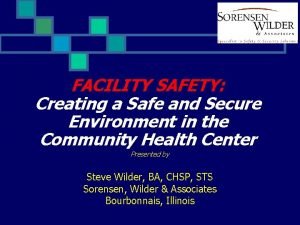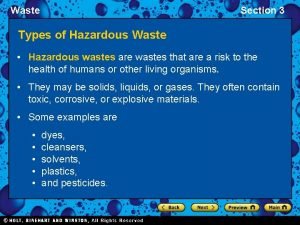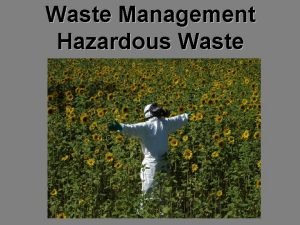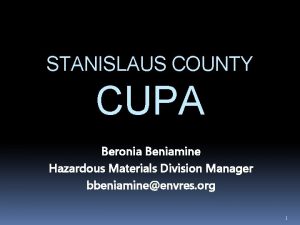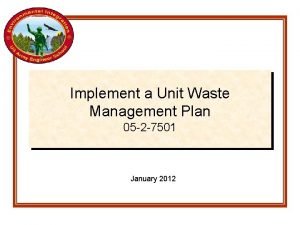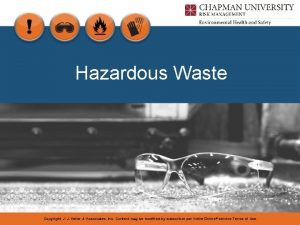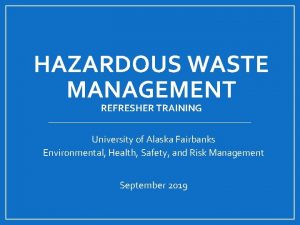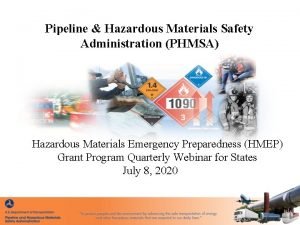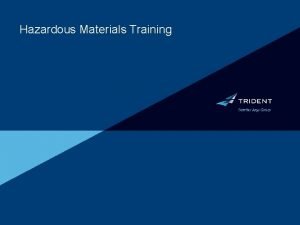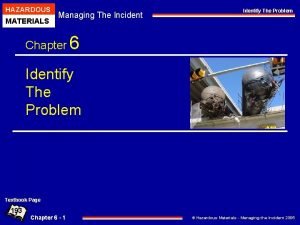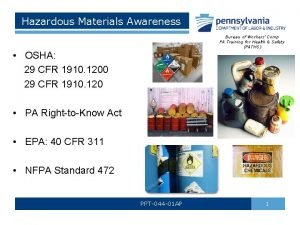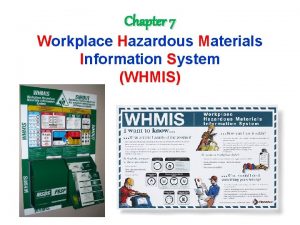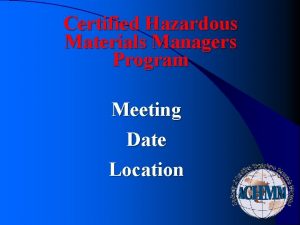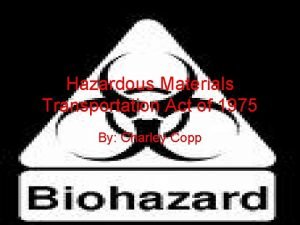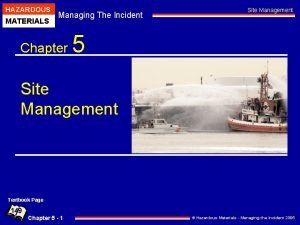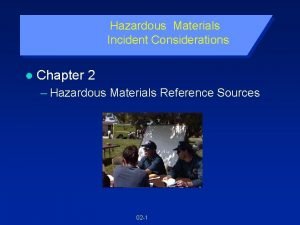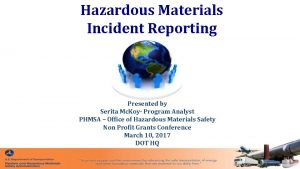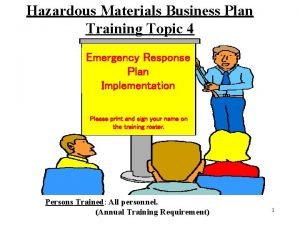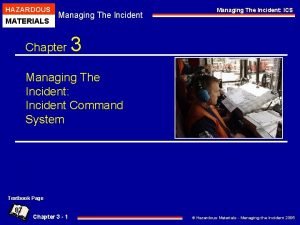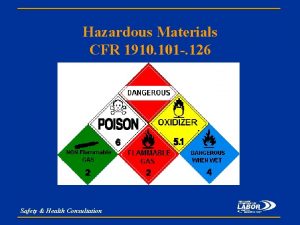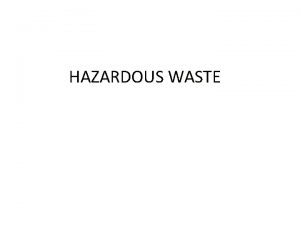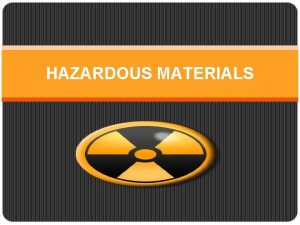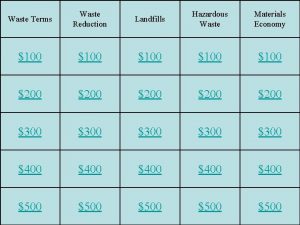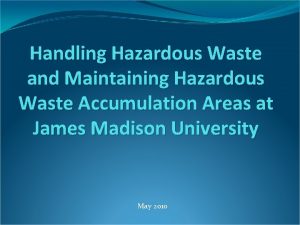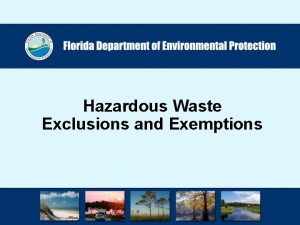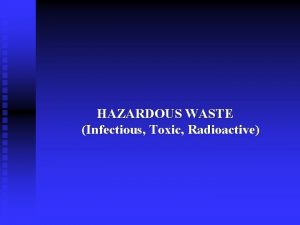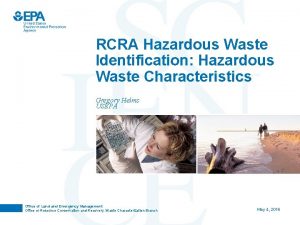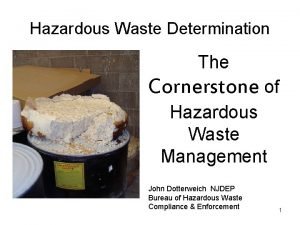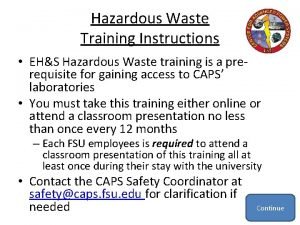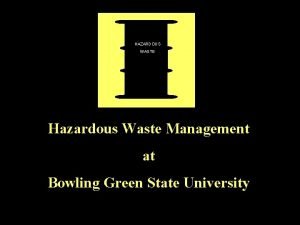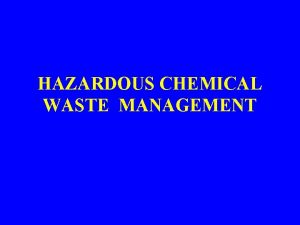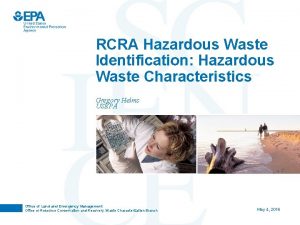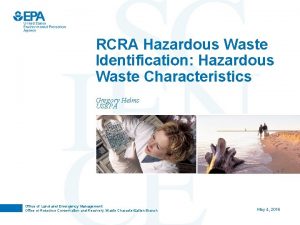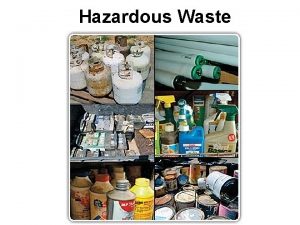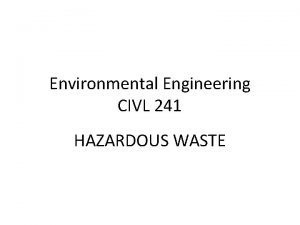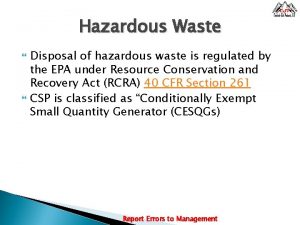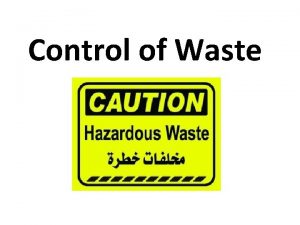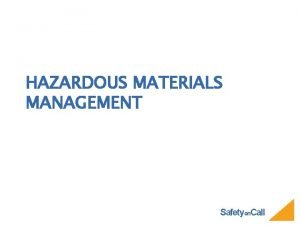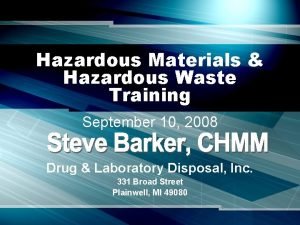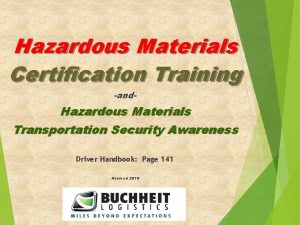Hazardous Materials Hazardous Waste Goal Providing Safe and




























- Slides: 28

Hazardous Materials – Hazardous Waste

Goal Providing Safe and Effective Hazardous Waste/Materials Training

Training Requirements Ø Training is required for all personnel who handle or are exposed to hazardous waste • AFI 32 -7042 ― All personnel whose work involves HW and their immediate supervisors must receive and successfully complete HW training appropriate to their job responsibilities.

LAWS, REGULATIONS AND POLICIES Ø Resource Conservation and Recovery Act of 1976 (RCRA). Ø AFI 32 -7042 Solid and Hazardous Waste Compliance. Ø Station Hazardous Waste Management Plan. Ø 29 CFR 1910. 106 Hazardous Materials.

Regulatory Background Ø Occupational Safety and Health Act (OSHA) • Establishes procedures and standards for the safe handling and storage of hazardous chemicals • Ensures that employees are made aware of the hazards posed by the chemicals in which they may come into contact • Established to create a safe work place

DEFINITIONS SOLID WASTE Any discarded material, gas, liquid, or solid which is abandoned, recycled, or considered inherently waste like. HAZARDOUS MATERIAL Any item or chemical which is a health hazard or physical hazard as defined by OSHA in 29 CFR 1910. 1200 which includes carcinogens, toxic, irritants, corrosives, sensitizers, combustibles, compressed gasses, explosives, flammables, oxidizers or reactive. HAZARDOUS WASTE Any solid waste that is either characteristic or a listed hazardous waste which must be managed in accordance with 40 CFR 260 -272 for treatment, storage or disposal. Waste that has certain properties or characteristics that could pose dangers to human health or the environment when discarded.

Satellite Accumulation Point Management Ø Satellite Accumulation Points (SAP) are the only areas designated for the collection of Hazardous Wastes. They should have signs identifying them as such. Ø The SAP must be located at or near the point of generation and be under the control of the operator. Ø Only wastes generated within the shop will be placed in SAP. Don’t accept wastes from other shops.

Satellite Accumulation Point Management Ø No more than 55 gallons of total waste are allowed in a SAP. Ø Containers must be closed at all times except when adding or removing waste. Ø Every SAP should have a binder with a SAP manager appointment letter from Squadron Commander, policy letters, training certificates, spill plan and the base Hazardous Waste Management Plan.

Turn-in Procedures ØGenerators are responsible for waste turn-in! • Contact Central Accumulation Point (CAP) to arrange pick up of wastes. • CAP personnel will provide new containers and evaluate the area for problems. • If new usable material, take to HAZMART with SDS.

Universal Waste Ø Any Hazardous Wastes that are subject to the Universal Waste requirements under 40 CFR part 273 Ø Universal Wastes are: • Fluorescent light bulbs any size or shape, sodium-vapor, high intensity discharge, neon, mercury vapor and metal halide lamps • Any battery, other than carbon or alkaline, and non-sealed lead acid. Before turn-in to CAP tape the contact terminals to prevent shorts • Pesticides • Mercury Thermostats Ø Universal Wastes do not have to be stored in a SAP.

Use This Label for Universal Waste Fill In Contents (Lamps, Batteries, etc. ) Fill Start Date For UW When Waste is First Put in Container Ø Containers must be properly labeled prior to adding waste. Ø Containers must be turned-in to CAP 9 months from start date. Ø Containers must be kept closed except when adding or removing waste. Remember to turn in containers 9 months from start date

Hazardous Materials Ø Hazardous materials commonly found at Barksdale • Flammable / Combustible • Corrosive • Reactive • Toxic • Compressed gases

Flammable / Combustible Materials Ø Flammable -- any substance having a flashpoint below 100°F Ø Combustible -- any substance having a flashpoint above 100°F

Corrosive Materials Ø Corrosive materials include any substance that can burn, irritate or attack organic tissue. • Includes materials that are strongly acidic or basic. Examples include: hydrochloric acid and caustic soda. ACID 0 Lead Acid / Battery Acid Neutral 2 7 BASE 12. 5 14 Potassium Hydroxide (used in Nickel Cadmium Acft Batteries)

Reactive Materials ØProperties of Reactive Materials • React violently with water (sodium or sulfuric acid) • Are explosive (munitions and flares) • Able to release toxic vapors or fumes (ammonia and bleach)

Toxic Materials Ø Chemicals for which there is evidence that exposure may cause adverse physical or health effects. Ø Employees must be made aware of any unique hazards to which they may be exposed by working with toxic chemicals.

Compressed Gases Ø Compressed Gasses include: • Gas or gas mixtures in a container with an absolute pressure exceeding 40 psi at 70°F. • Gas or gas mixtures in a container having an absolute pressure of 104 psi at 130°F regardless of the pressure at 70°F. • A flammable liquid having a vapor pressure exceeding 40 psi at 100°F. • For turn in of any of the materials listed in the previous five slides contact the CAP at 6 -8580.

Compressed Gas Storage Ø Key storage requirements for compressed gases • Store propane and other compressed gas fuel cylinders separate from flammable materials. • Secure large cylinders from tipping. • Separate incompatible gas cylinders in bulk storage (oxygen and acetylene). • Post NO SMOKING signs at storage facilities. • Label all storage containers.

Safety Data Sheets (SDS) ØYou must have access to data on the chemicals you use at work. ØRequired for all hazardous chemicals regulated under OSHA. ØMust include: • • • Manufacturer’s information Information on hazards PPE Fire response Ingredient characteristics Proper disposal instructions

Flammable / Combustible Storage Ø Storage in cabinets • • • Quantity restrictions based on Class of liquid Double-wall metal cabinets with three point lock 2 -inch secondary containment (nothing stored here) Labeled “FLAMMABLE-KEEP FIRE AWAY” Ventilation ports closed when placed inside Ventilation caps out when placed outside Ø Storage Inside Storage Rooms • • • Sill or ramp to contain spills (4 inch rise) Fire-resistant walls (2 -hour) Fire doors/ Fire Extinguisher within 10 ft outside the door Liquid tight floor joints Explosion-proof electrical wiring Adequate ventilation (six changes per hour)

Chemical Storage ØVerify that storage in cabinets meet the following • Materials within the cabinet are segregated. • No open containers within the cabinet. • All containers in the cabinet are labeled. • No materials stored on spill containment area in bottom of locker. Unsegregated Open containers Unlabeled materials

Wrong!! Visibility Obstructions Got a light? … Never cover Flammable Labels Foot lockers are not flam lockers

IDEAL ØEmergency Equipment Clear ØProper type of locker ØLocker Labeled ØContainment Pallet Utilized ØEverything Neat and Orderly

What’s Wrong With This Picture? Do Not Place Emergency Equipment Near Other Dangers Do Not Block Emergency Eye Wash / Showers

SPILL RECOVERY / CLEANUP ØYOUR RESPONSIBILITIES I. REPORT II. ASSIST III. CONTAIN IV. EVACUATE

SPILL RECOVERY / CLEANUP Ø Block drains with booms, drain pads, or by building stops around them with absorbent material. Ø Place contaminated pads and booms in plastic bags then into the containers provided in the spill response trailer. Ø Turn all waste in to your HAZWASTE Monitor for disposal at the CAP.

Ø Recycling Solid Waste reduces the amount placed in landfills Ø BAFB Recycling Center accepts • • Clean Corrugated Cardboard/Brown Bags Newspapers, Magazines, Junk Mail, Paper Aluminum and Steel Cans #1 and # 2 Plastics All items can be comingled in same container. 52 Brown Recycling containers throughout the base PLEASE, No Glass, Wood or Trash! Ø For Recycling Questions call 456 -5293 RECYCLE. It’s the right thing to do!

QUESTIONS
 Solid and hazardous waste
Solid and hazardous waste Safe and secure environment
Safe and secure environment Section 3 hazardous waste answers
Section 3 hazardous waste answers Color coding for waste disposal
Color coding for waste disposal Msw apes
Msw apes Hazardous waste examples
Hazardous waste examples Stanislaus county hazardous waste
Stanislaus county hazardous waste Segregation of hazardous waste
Segregation of hazardous waste Keller hazardous waste disposal
Keller hazardous waste disposal Hazmat training alaska
Hazmat training alaska Foodborne illness definition servsafe
Foodborne illness definition servsafe Pipeline and hazardous materials administration
Pipeline and hazardous materials administration Hazardous materials table
Hazardous materials table Hazardous materials table
Hazardous materials table Hazardous
Hazardous Hazwoper
Hazwoper What shape and color are the whmis 2015 symbols
What shape and color are the whmis 2015 symbols Isachmm
Isachmm Hazardous materials transportation act of 1975
Hazardous materials transportation act of 1975 Hazardous materials managing the incident
Hazardous materials managing the incident Hazardous materials reference books
Hazardous materials reference books Hazardous materials incident report
Hazardous materials incident report Hazardous materials business plan
Hazardous materials business plan Hazardous materials managing the incident
Hazardous materials managing the incident 29 cfr 1910 hazardous materials
29 cfr 1910 hazardous materials Safe feed safe food
Safe feed safe food Safe people safe places
Safe people safe places Go noodle cant stop the feeling
Go noodle cant stop the feeling Example of harmful and useful materials
Example of harmful and useful materials

